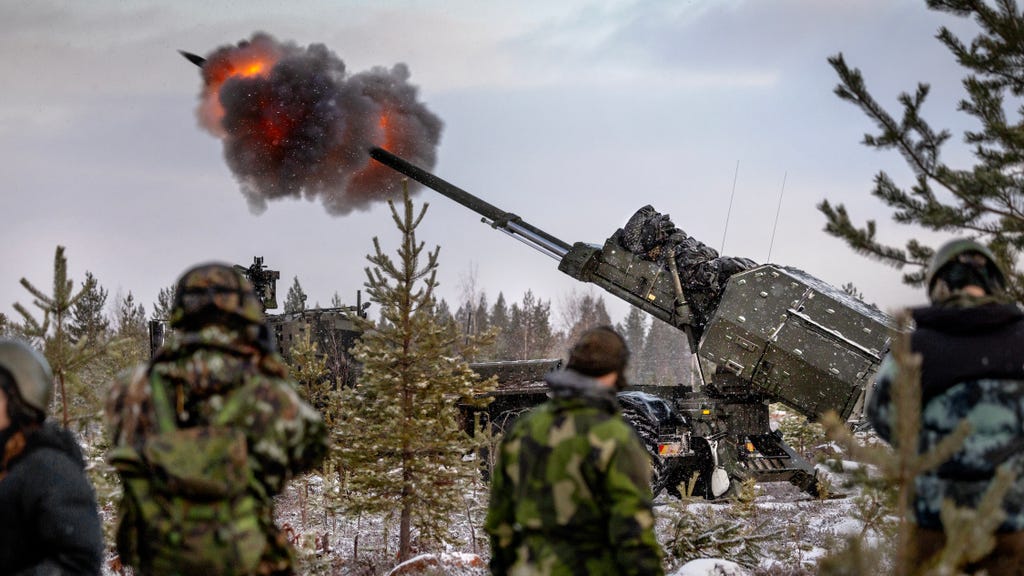The roar of the Archer artillery piece reverberated through the snowy Finnish wilderness, a stark demonstration of military might a mere hundred kilometers from the Russian border. A group of European and American journalists, transported to this barren expanse north of the Arctic Circle, witnessed the power of the Swedish weapon as it fired round after round, the acrid smell of gunpowder filling the air. This display was part of NATO’s largest-ever artillery exercise, a clear message of strength and readiness in a time of escalating global tension. Seventy Swedish soldiers, primarily from artillery regiments A8 and A9, had been encamped amidst the pine trees of the Rovajärvi firing range, participating in this crucial military exercise. While they performed their duties, news reports detailed Putin’s increasingly bellicose nuclear rhetoric and the integration of North Korean soldiers into the Russian army, alongside Biden’s authorization for Ukraine to utilize long-range ATACMS missiles against Russia.
The backdrop of this military exercise was the complex geopolitical landscape of Northern Europe, particularly Finland’s extensive border with Russia. The Murmansk region, home to a substantial Russian military presence including nuclear submarines, warships, and ground troops trained for Arctic warfare, posed a significant security concern. While Russian forces were currently depleted due to their involvement in the Ukrainian conflict, plans were underway to bolster their numbers significantly by 2026. This looming threat underscored the importance of NATO’s presence and the strategic role of Finland, particularly the northern regions, in the alliance’s defense planning. The Arctic, a new area of focus for NATO, necessitated increased cooperation between Finland, Sweden, and Norway to enhance security in Northern Europe.
Juxtaposed against the somber reality of military exercises and geopolitical strategizing was the whimsical world of Rovaniemi, the capital of Finnish Lapland, more commonly known as the home of Santa Claus. Tourists flocked to this winter wonderland, drawn by the magic of Christmas and the opportunity to meet the jolly figure in red. Families lined up for photos with Santa, strolled through the festive Santa Claus Village, and marveled at the snowy landscapes. Yet, amidst the holiday cheer, a growing presence of military personnel was noticeable, a subtle reminder of the region’s strategic importance and the underlying tensions that permeated the atmosphere. The presence of officers and fighter jets overhead during reindeer safaris served as a stark contrast to the festive spirit, a poignant reminder of the complex duality of this Arctic region.
Rovaniemi itself bore the scars of past conflicts. The city had been almost entirely destroyed during World War II by retreating German forces. Rebuilt from the ashes, its streets laid out in the shape of a reindeer’s head, Rovaniemi represented resilience and a forward-looking perspective. The influx of tourism and the adoption of Santa Claus as a central figure further solidified its transformation into a vibrant Arctic capital. However, the echoes of the past remained, most notably in the German soldier cemetery on the outskirts of the city, a stark reminder of the devastating impact of war and the enduring legacy of conflict. The frozen cemetery, with its rows of gravestones and granite mausoleum, served as a somber counterpoint to the festive atmosphere of the city center.
The strategic significance of Northern Finland was further emphasized by the presence of high-ranking military officials and the ongoing NATO exercises. Colonel Kimmo Kinnunen, commander of the Finnish Jaeger Brigade, highlighted Finland’s preparedness for potential military confrontation, a necessity given its long border with Russia. Collaboration between Sweden and Finland, particularly in the northern regions, was deemed crucial for the defense of the region. The “Type Situation 6” scenario, involving the reinforcement of NATO’s northern flank with Swedish forces, underscored the importance of joint operations in the event of a conflict. This collaboration extended to NATO’s Forward Land Forces (FLF), a multinational force positioned along the alliance’s eastern border. Sweden was tasked with leading the new FLF unit in Finland, a significant step in strengthening the region’s defense capabilities.
The presence of the American 56th Artillery Regiment Command at the Rovaniemi garrison underscored the international nature of the NATO exercises. General John Rafferty emphasized the importance of allied training, sending a clear message of strength and unity. While the official rhetoric avoided direct mention of Russia and Ukraine, the underlying context of the exercises was undeniable. The question of the United States’ future military role in Europe, posed by a journalist, highlighted the lingering uncertainties surrounding transatlantic security commitments. As the Swedish soldiers returned home after the exercise, the task of maintaining military readiness remained paramount. The experience of operating in the challenging Arctic environment, coupled with the understanding that ”Finland’s cause is our cause,” reinforced the commitment to regional security and the importance of international cooperation in the face of growing global tensions. The confluence of military exercises, historical legacies, and the festive spirit of Christmas created a unique and complex tableau in Rovaniemi, highlighting the delicate balance between peace and preparedness in a region of strategic importance.














